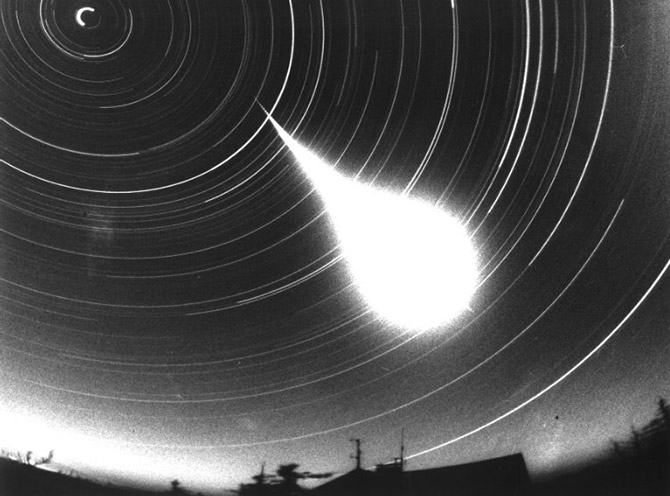
© NASA
A large fireball flashes across the night skies of the Irkutsk region of Siberia. What may have been a comet causes electrical circuits to come alive and leaves residents worrying about radioactivity.
Eyewitnesses saw the sky light up. More than a hundred people in the sparsely settled area reported seeing it.
At least one person fell to the floor in horror, believing that some religious
doomsday had arrived. Others were sure that nuclear war had broken out.
The region was in an accustomed power blackout that night. But even as the meteor's visible energy lit up the skies outside,
its strong electrical field activated the power grid. Residents reported that the lamps in their homes turned on for a few seconds.
People who were outside heard a buzzing, crackling sound in the air. The tops of fence posts lit up with
electrical discharges.
The impact shattered windows for a dozen miles around and was
felt up to 60 miles away. Scientists in Irkutsk recorded "
seismic waves comparable to a middle-power earthquake."
Early reports indicated that local people may have suffered mild radiation poisoning, symptomized by aching joints, kidney problems and high blood pressure.
Hunters who first explored the area near the presumed impact reported an area of downed trees surrounded by charred forest.
The
Institute of Solar and Earth Physics of the Siberian division of the Russian Academy of Sciences wanted to investigate, but was hampered by a lack of funds and the remoteness of the area. It was May 2003 before a scientific expedition could reach the hilly forests of
Bodaibo, northeast of Irkutsk, and Lake Baikal.
Scientists found about 40 square miles of trees smashed in the pattern associated with big explosions. The meteorite had broken up before hitting the ground and left a score of craters, up to 65 feet in diameter. Nearby tree stumps were shattered or burned.
A U.S. spy satellite that had picked up the blazing ball at about 40 miles altitude lost it a little below 20 miles: It's possible that's where the ball exploded.
U.S. military analysts estimated the explosion as equivalent to 0.2 to 0.5 kilotons, though Russian physicist Andrey Olkhovatov placed it much higher at 4 to 5 kilotons.
No large fragments were found, only tiny hollow spheres, generally less than 0.1 to 0.2 millimeters diameter. The brown and dark-brown particles contained oxide and silicate minerals typical of meteorites, along with pyrite with nickel content, and various iron compounds. None of these is typical of the local geology.
Some sources say
gamma radiation was at background level, but others say local
water samples showed high levels of tritium, along with radioactive isotopes of cobalt and cesium.
Whether the fireball was rock that pulverized or, as some Soviet scientists concluded, an icy comet, there's this scary fact to consider:
It was not picked up in advance by any existing warning systems. If the fireball had exploded on or over a major city, it could have killed tens of thousands of people.

Surely we will be prepared for the next disruption to our favorite tv programs? We can't have Nature demonstrating any crazy ideas about 'free energy' to us without govt oversight now can we?